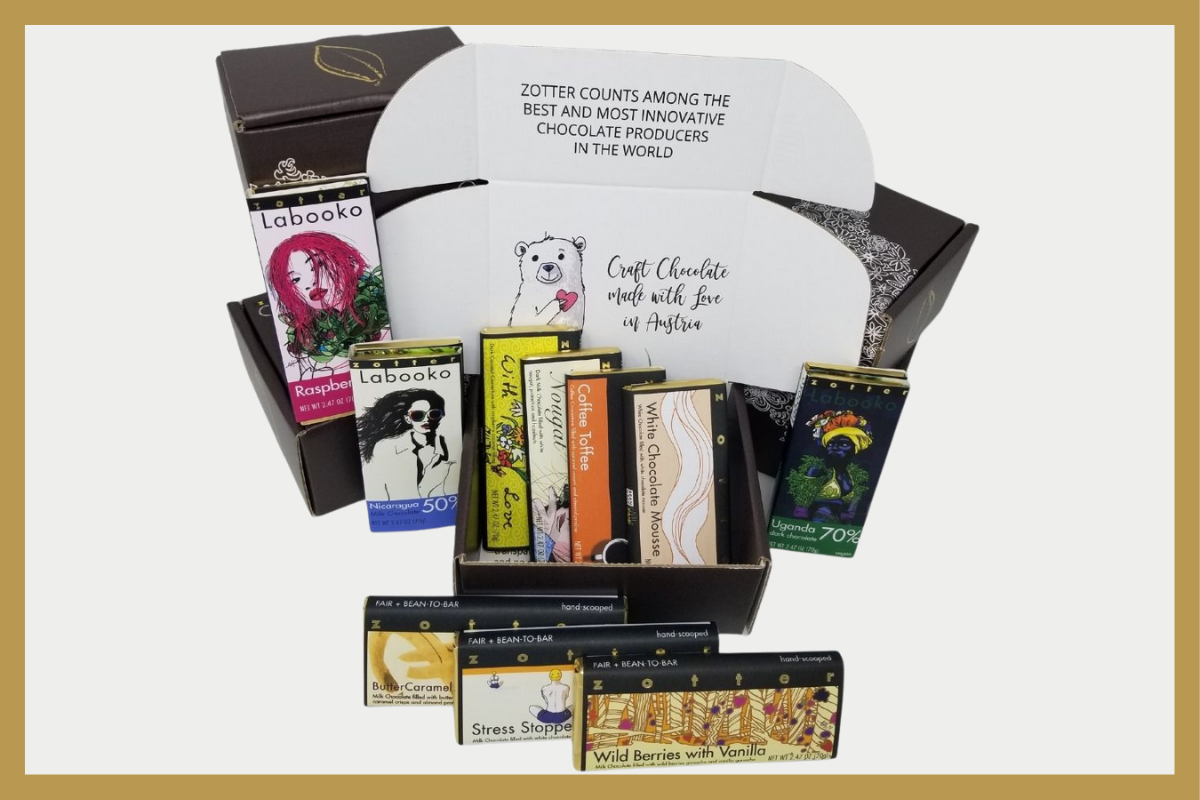Chocolate, often a symbol of indulgence and pleasure, carries a rich history and an equally rich range of qualities. From a quick convenience store fix to luxurious bonbons crafted by renowned chocolatiers, the spectrum of chocolate experiences is vast.
But what truly distinguishes high-quality chocolate? Is it the percentage of cocoa? The origin of the beans? Or is there more to it?
The pursuit of deciding what makes a premium chocolate bar, confection, or dessert is a delight in itself. This exploration takes us from the rainforests where cacao trees cultivate their precious pods to the precise and passionate artisans who turn cocoa into art.
In this thorough guide, we’re unwrapping the secrets of identifying high-quality chocolate. Whether you’re a cocoa connoisseur, a baker in pursuit of perfection, or simply someone seeking a more informed, delectable treat, this is your essential roadmap to chocolate quality.
Understanding Chocolate Types and Labels
Before we can talk about quality, we must understand the different types of chocolate and their labels. The main categories are defined by the percentage of cocoa solids, cocoa butter, sugar, and other ingredients like milk and vanilla:
- Dark Chocolate: Contains a higher proportion of cocoa solids, ranging from semi-sweet (generally around 50%) to bitter or bittersweet (upwards of 70%). The less sugar, the “darker” the chocolate. Generally, dark chocolate is made with cocoa and sugar. Sometimes you can find additional cocoa butter, salt, or vanilla added to give it more flavor.
- Milk Chocolate: A mixture of cocoa solids, cocoa butter, milk, and sugar, usually considerably sweeter than dark chocolate. There are exceptions, such as Zotter’s Milk Chocolate “dark style” and Milk Chocolate “super dark”, which are made with no added sugar.
- White Chocolate: Lacks cocoa solids and is made from cocoa butter, sugar, and milk, providing a creamy and sweet taste.
- Ruby Chocolate: Relatively new to the scene, ruby chocolate is a naturally pink chocolate with a slightly sour note, made from specially processed pink cacao beans.
- Unsweetened Chocolate: Also known as baking chocolate, it contains only cocoa solids and cocoa butter, meaning it’s incredibly bitter and not suitable for eating on its own. Also, there are exceptions to this rule, such as Zotter’s three 100% cacao bars, which are crafted in a way that they are edible and they also have a large fan base, especially health-conscious people.
Understanding the type of chocolate is essential, but the label might reveal more. Single-origin chocolates come from one specific region and may highlight certain flavors unique to the terroir.
Bean-to-bar chocolates are made by artisans who control the entire process, from sourcing the beans to producing the bars. Such distinctions may lead to heightened quality in the final product.
Origin Matters – The “Bean Terroir” Concept
The foundation of high-quality chocolate often begins with the cacao beans themselves. Just as with wine, the origin of the beans affects the taste. This concept, known as bean terroir, emphasizes the impact of the environment where the cacao is grown.
Factors such as soil, climate, topography, and even farming practices contribute to the flavor profile of the chocolate.
Some renowned cacao-producing regions include:
- Ghana: Famous for its “roasted” and “smoky” undertones.
- Madagascar: Distinctive “citrus” and “berry” flavors.
- Peru: Renowned for its “woody” and “earthy” elements.
- Belize: Rich beans with “fruity” and “floral” notes.
Single-origin chocolates that highlight these regional differences can often be indicators of higher quality and more complex flavor profiles.

Beans from a single estate or even a specific farmer further narrow down the taste to a single plot of land, which can lead to an even more refined and unique chocolate experience.
At Zotter, we list flavor profiles on each single-origin Labooko bar. On the website as well as inside of the packaging.
The Role of Cocoa Percentage
One of the most common benchmarks for assessing the quality of dark chocolate is its cocoa percentage. This number represents the total amount of the bar’s weight that comes from cocoa beans (cocoa solids and cocoa butter), and a higher percentage generally means a more intense and complex chocolate flavor with less sweetness.
However, this is just one piece of the quality puzzle, and a high percentage does not necessarily equate to the best-tasting chocolate for everyone’s palate.
It’s crucial to recognize that a higher cocoa percentage can sometimes mask the inherent flavors of the beans, which might not be ideal in all applications.
For other uses, such as baking where sweetness plays an equal role, a lower cocoa percentage could be the wiser choice.
The Conching Process and Chocolate Texture
The conching process is often misunderstood but remains crucial in chocolate production, focusing on aerating the chocolate and finalizing its flavor by removing unwanted aromas.
Contrary to popular belief, the “smoothness” of the chocolate is not achieved during conching but rather through the milling process. The use of precise machinery, such as the ball mill and roll mill,determines the smoothness of the chocolate and the size of its particles.
Conching serves to incorporate air, enhance flavors, and eliminate any undesirable acidic or bitter notes, with high-quality chocolate benefiting from a longer duration to refine its taste.
High-quality chocolate undergoes different levels of conching period ranging from 8 to 40 hours depending on the type of beans and the flavor desired. At Zotter our conching specialists or conchmasters determine the perfect conching time for each type of beans to achieve the perfect blend of texture and flavor.
Chocolate that feels “gritty” or “waxy” likely did not undergo proper milling and conching and could be an indicator of a lower-quality product. In contrast, creamy and velvety chocolate suggests meticulous processing and, often, a more satisfying consumer experience.
Chocolate and Health
For many, the benefits of chocolate are a significant consideration when determining quality.
Dark chocolate, in particular, is recognized for its potential health advantages. It contains antioxidants, and minerals like iron, magnesium, and zinc, and can even improve cardiovascular health. Indulge in our wide range of dark chocolate varieties to enjoy the pure bliss of chocolate healthily.
The higher the quality of the chocolate and the purer the cocoa content, the more health benefits it can offer.
On the flip side, the addition of excessive sugar, additional fats, and artificial flavors in lower-quality chocolates may outweigh any healthful aspects. It’s essential to consider not just the flavor and texture but also the nutritional value when evaluating chocolate.
Sustainable and Ethical Chocolate
The highest quality chocolate is not only delectable but also produced responsibly. Sustainable and ethical practices ensure that the farmers who grow the cacao are fairly compensated and the environment is protected.
High-quality chocolate often comes with certifications like Fairtrade, Rainforest Alliance, or Organic, ensuring that consumers are making a positive choice with their purchase.
When chocolate is ethically sourced, you can enjoy it with the knowledge that it represents not only good taste but also a conscientious effort to create a more equitable and sustainable world.
At Zotter Chocolates, we ensure our chocolates are organic and are sourced from plantations where fair trade practices are upheld. Zotter is proudly Fair Trade Verified by the World Fair Trade Organization, WTFO, which is the Umbrella Organization for Fairtrade™.
The Sensory Experience
Assessing chocolate quality is ultimately a sensory experience. When tasting chocolate, pay attention to the following senses:
- Sight: High-quality chocolate should have a consistent color and a glossy sheen. A dull or mottled appearance can be a sign of poor tempering or storage conditions.
- Touch: A quality chocolate bar should feel smooth and free of imperfections.
- Taste: Each chocolate type (dark, milk, white) has distinct elements to consider. For dark chocolate, look for a rich, complex flavor that lingers. For milk chocolate, a creamy texture and a balanced level of sweetness. White chocolate should be rich and creamy without being overly sweet.
- Smell: The aroma of good chocolate should be rich and inviting, without any off-putting scents.
- Sound: Breaking a piece of chocolate should produce a clean snap, indicating proper tempering and a well-structured bar.
By engaging all the senses, you can more thoroughly appreciate and assess the chocolate you are experiencing.
Conclusion
The world of chocolate is as vast and varied as can be, and the pursuit of identifying high-quality chocolate is a lifelong adventure. Whether you’re a passionate enthusiast, a discerning chef, or simply a lover of the cocoa bean, understanding what sets a bar apart will enhance your appreciation and enjoyment of this ancient and beloved confection.
In sum, the hallmarks of high-quality chocolate result from a harmonious blend of craftsmanship, fine ingredients, and ethical practices. Each element, from bean terroir to roasting, milling, and conching methods, works in orchestration to produce a chocolate that delights the senses and fulfills the ethical aspirations of today’s consumers.
May your chocolate encounters be as enriching as indulgent, reminding us that with each delectable bite, we share a story that spans generations and reaches every corner of the globe.
About Zotter Chocolates
Embark on a sensory journey with Zotter Chocolates, where every piece is a testament to the soulful essence of Bean-To-Bar, organic, and fair trade practices. Savor the results of 30+ years of passionate craftsmanship, as each bite whispers tales from Austria’s heartlands.
Let the unique and distinct flavors of our chocolates embrace your senses, reminding you of the love and dedication poured into every piece. Our diverse range boasts approximately 170 different varieties, offering something to satisfy every palate.
Will your next favorite be the hand-scooped chocolates or perhaps the Currant’N’Chili, with its unexpected yet harmonious fusion of flavors? Or will you be drawn to the exquisite dark, single-origin Labooko bar, a true purist’s delight? Join us in the pursuit of chocolate perfection, where every piece is a piece of joy, waiting to be discovered.


